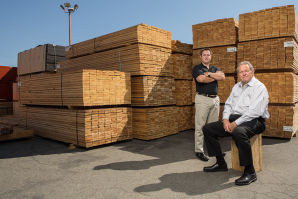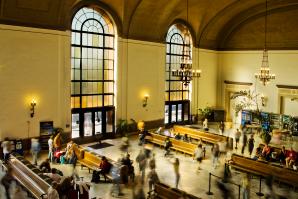The way cities plan and lay out their communities has a direct correlation on residents’ health and lifestyles. According to the city’s community director Ken Hiatt, Woodland — like the rest of the United States — is “at a crisis that our elected folks here and people in the community are aware of from a health standpoint.”
It’s been a year since Gov. Jerry Brown signed legislation that created the Active Transportation Program to boost non-motorized transportation across the state, where one in four Californians are obese and more than 3.9 million are diabetic. And as California emerges as a national leader in transportation reform, Yolo County is finding itself at the forefront of the movement.
Improvements are transforming public transit, bicycle and pedestrian accessibility in Davis, West Sacramento, Woodland and Winters. Projects range from street overlays and bike lane installations to major multi-city construction ventures, including relocating the Yolo County Rail Line.
Hiatt was born in Davis and worked there for over 20 years, taking mental notes the entire time. He jokes that he was “riding a bike before [I] was walking” and brought many of the values that fostered Davis’ active transportation network with him to Woodland.
Active transportation is a clear priority in Davis, which has historically been ahead of the curve when it comes to biking and walking. Its streets connect to an integrated “greenbelt” network of bicycle and pedestrian paths that make it possible to get just about anywhere in the city without a car.
Hiatt says the focus in Woodland on creating a more active city “is the right thing to do, and it’s essential.”
Major projects underway include creating a gap-free bike and pedestrian network connecting to the city’s main arterial streets. Woodland is installing a class I bike facility — an off-street, protected bikeway — on top of a pipeline easement to connect Woodland’s east and west sides from the north side of Farmer Central Road across Highway 113 to Ashley Drive. Ashley Drive then connects to main streets — all with class II facilities (designated bike lanes along car roads) — that route to the city’s urban street network.
Adding bike lanes on existing roadways can cost as relatively little as $10,000 per mile segment, but costs soar when streets need widening, gutters, drainage, sidewalks, signage and lights.
“Once you open up the box,” Hiatt says, “it gets really complicated and real expensive very quickly.”
Winters has also made pedestrian-friendly developments to its downtown streets, including the renovation of the historic Trestle Bridge along Railroad Street for pedestrian and bike access.
One of the county’s biggest projects is the planned Yolo Rail Line relocation, which involves Davis, Woodland and West Sacramento. In September 2014 the three cities, along with the Sacramento Area Flood Control Agency, secured a $171,000 grant to analyze the economic impact of the proposed project.
If approved, SAFCA would relocate the rail line that currently runs through the center of Woodland and Davis to east of Woodland, around Davis and extending west of West Sacramento and its port.
The potential for development in urban areas currently impeded by the rail line is immense. The project would also boost flood protection by providing for the removal of the Yolo Bypass short line trestle, says Terry Bassett, Yolo County Transportation District Executive Director.
The rail line relocation coupled with the West Sacramento-Sacramento urban streetcar, which could be running as soon as 2018 and is estimated to cost $150 million, would be among the most expensive and potentially transformative transportation projects in the region’s history.
Two smaller projects will have a more immediate impact.
The county’s bike share program — spearheaded by the Sacramento Metropolitan Air Quality Management partnering with regional cities, transportation agencies and transit operators — will bridge the gap between public transit and riders’ ultimate destinations.
Approximately 80 designated “pods” near bus stops in Sacramento, West Sacramento and Davis will offer bicycles that can be rented and dropped off at any of the other locations. Bassett hopes the service will be in effect by 2015.
Regional transit operators are also moving to a universal “smart card” method of payment. Connect Card will allow riders to pay for and ride RT services in six different counties with one fare card.
These transportation reforms large all indicate a shift from the automobile-dependant nature of the county. As these four cities grow and develop to meet their own disparate needs, they are also working toward common goals — greener grids, active urban centers, and healthier populations — that will redefine Yolo County in the new age of California transportation.
Check back next week for John Blomster’s feature on upcoming changes to Yolo County’s transportation grid. Sign up for our newsletter, and we’ll send you an email when it’s online.
Recommended For You

On the Cover: The World’s Fastest Man
Rome wasn't built in a day, because C.C. Myers didn't have that contract
Construction guru C.C. Myers has, for more than two decades, been California’s go-to guy when roads are ravaged by acts of God (like the ’94 Northridge earthquake) or the toll of time (Folsom’s Lake Natoma Crossing, Interstate 5 in Sacramento, Route 99 in Turlock, the Walnut Creek Interchange, and the list goes on). The New York Times once called him the “Miracle Worker Highway Man.”

Railway Station Revamp
Updates to Sacramento Valley Station include bike rentals and rooftop patio
At 88 years old, the Sacramento Valley Station at 4th and I streets is bound for new glory, as the second phase of the $34-million rejuvenation project gets underway at the city’s downtown transportation hub.

#YOLO
The 7 best bike rides in Yolo County
Lovely scenery along gently rolling foothills has always made Yolo County an ideal place for cyclists, but who knew everyone took it so seriously?

Streetcar Named Desire
Funding questions loom over downtown streetcar project
For nearly two decades, local city officials have envisioned a streetcar that would transport residents and visitors across downtown Sacramento.




Comments
"If approved, SAFCA would relocate the rail line that currently runs through the center of Woodland and Davis to east of Woodland, around Davis and extending west of West Sacramento and its port."
That's totally wrong. You are talking about two different railroads and combining them into one in your text, vastly oversimplifying the project. Such poor reporting does nothing for getting out the truth to readers.
"The potential for development in urban areas currently impeded by the rail line is immense."
In West Sacramento, an entirely separate project, the word "immense" may be justified. However, for the rest of the County, not so much, and certainly not worth the "immense" cost and complications to pull this off.
"The project would also boost flood protection by providing for the removal of the Yolo Bypass short line trestle, says Terry Bassett, Yolo County Transportation District Executive Director."
The same amount of flood protection, i.e. allowing for removal of the trestle, could be accomplished for literally 5% or less of the cost of the "immense"-ly hubristic project, through a simple track connection and haulage rights agreement. But it wouldn't get the developers what they perceive as a massive federal subsidy to open up land.
This project is so complex, so much more expensive than is being advertised, and so far in the future, that no one should be taking this seriously, or spending all this time and money on it. The players are playing the players here, and a few consultants are making some nice coin.